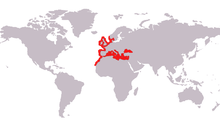
Back شبص أوروبي Arabic أبلاغ ARY شبص اوروبى ARZ Dicentrarchus labrax AST Lavrak AZ Морски вълк Bulgarian Draeneg BR Lubin (riba) BS Llobarro Catalan Dicentrarchus labrax CEB
| European seabass | |
|---|---|

| |
| Scientific classification | |
| Domain: | Eukaryota |
| Kingdom: | Animalia |
| Phylum: | Chordata |
| Class: | Actinopterygii |
| Order: | Acanthuriformes |
| Family: | Moronidae |
| Genus: | Dicentrarchus |
| Species: | D. labrax
|
| Binomial name | |
| Dicentrarchus labrax | |

| |
| Distribution of European seabass | |
| Synonyms | |
|
click to expand
| |
The European seabass (Dicentrarchus labrax), also known as the branzino, European bass, sea bass, common bass, white bass, capemouth, white salmon, sea perch, white mullet, sea dace or loup de mer, is a primarily ocean-going fish native to the waters off Europe's western and southern and Africa's northern coasts, though it can also be found in shallow coastal waters and river mouths during the summer months and late autumn. It is one of only six species in its family, Moronidae, collectively called the temperate basses.
It is fished and raised commercially and is considered the most important fish currently cultured in the Mediterranean. In Ireland and the United Kingdom, the popular restaurant fish sold and consumed as sea bass is exclusively the European bass.[2] In North America, it is widely known by one of its Italian names, branzino.[3]
European seabass is a slow-growing species that takes several years to reach adulthood. An adult European seabass usually weighs around 2.5 kg (5.5 lb). European seabass can reach measurements of up to 1 m (3 ft 3 in) in length and 12 kg (26 lb) in weight, though the most common size is only about half of that at 0.5 m (1 ft 8 in). Individuals are silvery grey and sometimes a dark-bluish color on the back.
Juveniles form schools and feed on invertebrates, while adults are less social and prefer to consume other fish. They are generally found in the littoral zone near the banks of rivers, lagoons, and estuaries during the summer and migrate offshore during the winter. European sea bass feed on prawns, crabs and small fish. Though it is a sought-after gamefish, it is listed as Least Concern by the International Union for Conservation of Nature because it is widespread and there are no known major threats.
- ^ Freyhof, J.; Kottelat, M. (2024). "Dicentrarchus labrax". IUCN Red List of Threatened Species. 2024: e.T135606A21912674. doi:10.2305/IUCN.UK.2024.RLTS.T135606A21912674.en. Retrieved 18 November 2021.
- ^ "Sea Bass: the Superstar of the Seas". The Independent. 22 October 2011. Retrieved 2017-12-02.
- ^ "Definition: Branzino". Popsugr Food. Retrieved 2017-12-02.
